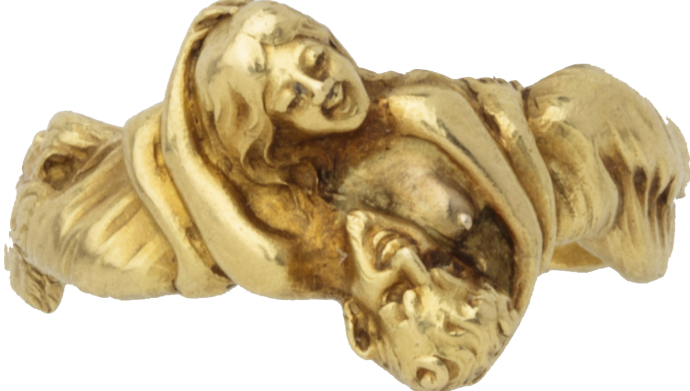


Art Nouveau Nymph and Satyr Ring by Arvisenet
, c. 1900



Art Nouveau Nymph and Satyr Ring by Arvisenet
Description
This sculptural ring is cast in gold and finely chased. The hoop is flat inside, while outside two entwined figures form the shoulders and bezel. A satyr with hairy legs, hooves, and a tail embraces a half-nude nymph with long, flowing hair and drapery below the hips. Engraved inside the hoop is the name of the maker, “ARVISENET cis.” At the bottom of the hoop on the outside is the French warranty mark for gold, an eagle with head facing left,1 and a lozenge-shaped maker’s mark, with the initials “A” and “S” flanking crossed swords. Here is a ring that adopts a completely sculptural form, all the more remarkable on account of its kinetic quality. In its close relationship to sculpture it foreshadows art jewelry of the later twentieth and twenty-first centuries, when artists like Pablo Picasso, Alexander Calder, Anish Kapoor, and others likewise adept at monumental large-scale sculptural compositions were making jewelry as well.
The nymph and satyr whose embrace encompasses this ring’s hoop form a dynamic sculpture to be worn upon the finger and reflect a new era of sensuality and eroticism in the arts and jewelry. This ring owes its imagery to ancient Greek mythology, by way of the later Baroque and Neo-Classical periods.
This ring allows us to point to another sculptor, likely based in Paris, who had also embraced this motif. The inscription in the ring, “ARVISENET cis,” may refer to Léon or Marcel Léon Arvisenet, recorded in 1909.
Provenance:
Raphael Esmerian, Paris and New York (1903-1976).
Literature:
Scarisbrick, Diana. Rings: Jewelry of Power, Love and Loyalty. London: Thames and Hudson, 2007 (repr. 2014), pp. 278-79, figs. 386-87.
